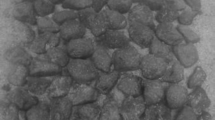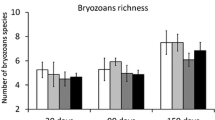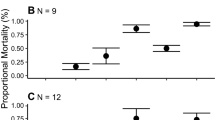Summary
Predation intensity often increases along local gradients of decreasing environmental rigor. Assuming factors such as productivity and heterogeneity do not change along such gradients, potential factors responsible for this pattern include: (1) increased effectiveness per individual predator, (2) increased numbers of individual predators, (3) increased numbers of predator species of the same general morphological attributes, and (4) increased numbers of predator species of different general morphological attributes. I term these factors the components of predation intensity.
In relatively protected low rocky intertidal regions of northern New England, community structure depends in part on the foraging activities of up to six species (three general types) of predators (Lubchenco and Menge 1978). These include three species of crab, two species of seastars, and one thaidid gastropod. This predator guild prevents mussel and barnacle populations from outcompeting Chondrus crispus. This red alga dominates space when predators are present, but is outcompeted by mussels when predators are excluded.
Prey consumption rates (mg per predator individual per hr or mg g-1 hr-1) in field experiments indicate that the rank from most to least effective predator type is crabs, seastars, and the gastropod. Statistically significant variations occur between predator types (largest differences), species of a given type, and individuals of a species (smallest differences). Estimates of the relative contribution of each species to total predation intensity in the low zone at several sites indicate that each predator species is a major predator at one or more sites. Thus, if one predator species in this guild becomes scarce, the other predators may increase their effects and reduce variation in the total predation intensity exerted by the guild. Comparisons with other systems suggest that increased diversity of types of foraging characteristics in predatory guilds is an important component of increased predation intensity along gradients of decreased environmental rigor.
Similar content being viewed by others
References
Addicott J (1974) Predation and prey community structure: an experimental study of the effect of mosquito larvae on the protozoan communities of pitcher plants. Ecology 55:475–492
Caswell H (1978) Predator mediated coexistence: a nonequilibrium model. Am Nat 112:127–154
Connell JH (1975) Some mechanisms producing structure in natural communities: a model and evidence from field experiments. In: Cody ML, Diamond JM (eds) Ecology and Evolution of Communities. Belknap Press of Harvard University Press, Cambridge, MA, pp 460–490
Connell JH (1978) Diversity in tropical rain forests and coral reefs. Science 199:1302–1310
Day RW (1977) Two contrasting effects of predation on species richness in coral reef habitats. Mar Biol 44:1–5
Dayton PK (1971) Competition, disturbance, and community organization: the provision and subsequent utilization of space in a rocky intertidal community. Ecol Monogr 41:351–389
DeAngelis DL (1975) Stability and connectance in food web models. Ecology 56:238–243
Edwards DC, Conover DO, Sutter III F (1982) Mobile predators and the structure of marine intertidal communities. Ecology 63:1175–1180
Elner RW (1978) The mechanics of predation by the shore crab, Carcinus maenas (L.), on the edible mussel, Mytilus edulis L. Oecologia (Berlin) 36:333–344
Elton CS (1958) The ecology of invasions of animals and plants. Methuen, London
Gaines SD (1982) Diverse consumer guilds in intertidal communities of Oregon and the Republic of Panama and their effects on prey assemblages. Ph.D. Thesis, Oregon State University, Corvallis, 133 p
Gaines SD, Lubchenco J (1982) A unified approach to marine plant-herbivore interactions. II. Biogeography. Ann Rev Ecol Syst 13:111–138
Harper JL (1977) Population biology of plants. Academic Press, New York
Huston M (1979) A general hypothesis of species diversity. Am Nat 113:81–101
Hyman LH (1955) The invertebrates: Echinodermata. (Vol IV). McGraw-Hill Book Co., New York, 763 pp
Hyman LH (1967) The invertebrates: Mollusca I (Vol VI). McGraw-Hill Book Co., New York, 792 pp
Kitching JA, Sloan JF, Ebling FJ (1959) The ecology of Lough Ine. VIII. Mussels and their predators. J Anim Ecol 28:331–341
Lubchenco J (1978) Plant species diversity in a marine intertidal community: importance of herbivore food preference and algal competitive abilities. Am Nat 112:23–39
Lubchenco J, Menge BA (1978) Community development and persistence in a low rocky intertidal zone. Ecol Monogr 48:67–94
Lubchenco J, Gaines SD (1981) A unified approach to marine plant-herbivore interactions. I. Populations and Communities. Ann Rev Ecol Syst 12:405–437
Lynch M (1979) Predation, competition, and zooplankton community structure: an experimental study. Limnol Oceanogr 24:253–272
MacArthur RH (1955) Fluctuations of animal populations, and a measure of community stability. Ecology 36:533–536
Mauzey KP, Birkeland CE, Dayton PK (1968) Feeding behavior of asteroids and escape responses of their prey in the Puget Sound region. Ecology 49:603–619
May RM (1974) Stability and complexity in model systems. Princeton University Press, Princeton, New Jersey
McCauley E, Briand F (1979) Zooplankton grazing and phytoplankton species richness: field tests of the predation hypothesis. Limnol Oceanogr 24:243–252
Menge BA (1972) Foraging strategy of a starfish in relation to actual prey availability and environmental predictability. Ecol Monogr 42:25–50
Menge BA (1976) Organization of the New England rocky intertidal community: role of predation, competition and environmental heterogeneity. Ecol Monogr 46:355–393
Menge BA (1978a) Predation intensity in a rocky intertidal community. Relation between predator foraging activity and environmental harshness. Oecologia (Berlin) 34:1–16
Menge BA (1978b) Predation intensity in a rocky intertidal community. Effect of an algal canopy, wave action and desiccation on predator feeding rates. Oecologia (Berlin) 34:17–35
Menge BA (1979) Coexistence between the seastars Asterias vulgaris and A. forbesi in a heterogeneous environment: a non-equilibrium explanation. Oecologia (Berlin) 41:245–272
Menge BA (1982a) Asteroidea: Effects of feeding on the environment. In: Jangoux M, Lawrence J (eds) Echinoderm Nutrition. A.A. Balkema, Rotterdam, The Netherlands (in press), pp 521–551
Menge BA (1982b) Reply to a comment by Edwards, Conover and Sutter. Ecology 63:1180–1184
Menge BA, Sutherland JP (1976) Species diversity gradients: synthesis of the roles of predation, competition and temporal heterogeneity. Am Nat 110:351–369
Menge BA, Lubchenco J (1981) Community organization in temperate and tropical rocky intertidal habitats: prey refuges in relation to consumer pressure gradients. Ecol Monogr 51:429–450
Menge J, Lubchenco, Menge BA (1974) Role of resource allocation, aggression, and spatial heterogeneity in coexistence of two competing intertidal starfish. Ecol Monogr 44:189–209
Neter J, Wasserman W (1974) Applied linear statistical models. Richard D. Irwin, Inc., Homewood, Illinois
Paine RT (1966) Food web complexity and species diversity. Am Nat 100:65–75
Paine RT (1969a) A note on trophic complexity and community stability. Am Nat 103:91–93
Paine RT (1969b) The Pisaster-Tegula interaction: prey patches, predator food preference and intertidal community structure. Ecology 50:950–961
Paine RT (1971) A short-term experimental investigation of resource partitioning in a New Zealand rocky intertidal habitat. Ecology 50:1096–1106
Paine RT (1974) Intertidal community structure: experimental studies on the relationship between a dominant competitor and its principal predator. Oecologia (Berlin) 15:93–120
Paine RT (1976) Size-limited predation: an observational and experimental approach with the Mytilus-Pisaster interaction. Ecology 57:858–873
Paine RT (1977) Controlled manipulations in the marine intertidal zone, and their contributions to ecological theory. In: The changing scenes in natural sciences, 1776–1976. Academy of Natural Sciences, Spec. Publ. 12, pp 245–270
Paine RT (1980) Food webs: linkage, interaction strength and community infrastructure. J Anim Ecol 49:667–685
Paine RT, Vadas RL (1969) The effects of grazing by sea urchins, Strongylocentrotus spp. on benthic algal populations. Limnol Oceanogr 14:710–719
Peterson CH (1979a) The importance of predation and competition in organizating the intertidal epifaunal communities of Barnegat Inlet, New Jersey. Oecologia (Berlin) 39:1–24
Peterson CH (1979b) Predation, competitive exclusion, and diversity in soft-sediment benthic communities of estuaries and lagoons. In: Livingston RJ (ed) Ecological processes in coastal and marine systems. Plenum Publishing Corp
Pimm SL (1980) Food web design and the effect of species deletion. Oikos 35:139–149
Reise K (1977) Predation exclusion experiments in an intertidal mud flat. Helg Wiss Meersunters 30:263–271
Russ GR (1980) Effects of predation by fishes, competition, and structural complexity of the substratum on the establishment of a marine epifaunal community. J Exp Mar Biol Ecol 42:55–69
Seed R (1969) The ecology of Mytilus edulis L. (Lamellibranchiata) on exposed rocky shores II. Growth and mortality. Oecologia (Berlin) 3:317–350
Sloan NS (1980) Aspects of the feeding biology of asteroids. Oceanogr Mar Biol Ann Rev 18:57–124
Sokal RR, Rohlf FJ (1969) Biometry. W.H. Freeman and Company. San Francisco, California
Van Blaricom GR (1982) Experimental analyses of structural regulation in a marine sand community exposed to oceanic swell. Ecol Monogr 52:283–305
Vance RR (1978) Predation and resource partitioning in one predator-two prey model communities. Am Nat 112:797–813
Virnstein RW (1977) The importance of predation by crabs and fishes on benthic infauna in Chesapeake Bay. Ecology 58:1199–1217
Woodin SA (1981) Disturbance and community structure in a shallow water sand flat. Ecology 62:1052–1066
Zaret TM (1981) Predation and freshwater communities. Yale University Press, New Haven
Author information
Authors and Affiliations
Rights and permissions
About this article
Cite this article
Menge, B.A. Components of predation intensity in the low zone of the New England rocky intertidal region. Oecologia 58, 141–155 (1983). https://doi.org/10.1007/BF00399210
Received:
Issue Date:
DOI: https://doi.org/10.1007/BF00399210




